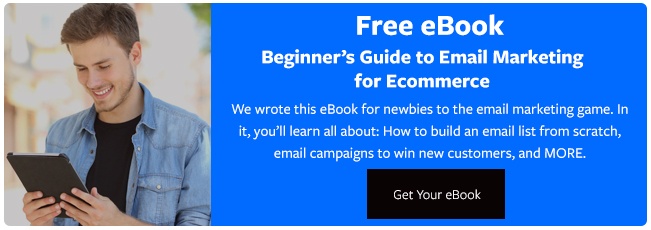
Inbound and outbound marketing are both powerful tools in their own right. Knowing how to market your product or service is one of the most essential tasks for any business, whether a start-up or a big corporation.
So, which marketing method is the best for your eCommerce business? Let’s explore inbound and outbound marketing, their differences, benefits, and how you can use them to transform your marketing processes.
What is Inbound Marketing?
Inbound marketing is a customer-led approach to marketing that focuses on attracting, engaging, and winning over potential customers by providing valuable and relevant content.
The main goal of inbound marketing is to draw potential customers to your brand naturally and organically rather than actively pushing promotional messages to them. Some customers may prefer this as it feels less “salesy” and more genuine.
Essentially, the inbound marketing approach recognizes that consumers today are more empowered and information-driven than ever before. Rather than interrupting potential customers with unwanted advertisements, inbound marketing aims to build trust, credibility, and authority.
Examples of Inbound Marketing
Let’s look at some classic examples of inbound marketing:
- Blogging: Create and maintain a blog that provides valuable and relevant content to your target audience. For example, an eCommerce store selling fitness equipment might publish blog posts about workout tips, healthy recipes, or the benefits of different exercise routines.
- Email Marketing: Send targeted and personalized emails to nurture leads and stay connected with customers. This could include sending your email subscribers a mass email with exclusive discounts and product recommendations.
- Content Offers and Lead Magnets: Provide valuable resources or incentives in exchange for contact information. For instance, a software company might offer a free e-book or whitepaper on a relevant industry topic to capture leads.
- Video Marketing: Create informative or entertaining videos that resonate with your target audience. For example, an eCommerce cooking equipment store might create recipe tutorial videos or product demonstrations.
- Podcasting: Host a podcast that covers topics of interest to your target audience. A pet supplies store could have a podcast discussing pet care tips, training techniques, and interviews with animal experts.
- Webinars and Online Events: Host webinars or virtual events that provide valuable insights or solutions to your audience's problems. You might conduct a webinar on effective time management for entrepreneurs.
What is Outbound Marketing?

Outbound marketing takes a more traditional marketing approach. When we think of “marketing,” these methods may be the ones that cross our minds. It involves pushing promotional messages to a broad audience to generate immediate sales or leads.
However, unlike inbound marketing, which aims to attract customers naturally through valuable content optimization and engagement, outbound marketing takes a more proactive and direct approach to reaching potential customers.
These strategies often focus on creating awareness and reaching a broad audience. They rely on the company's message being seen or heard by many people in the hope of capturing the attention of potential customers.
This marketing method may seem outdated, especially with consumer behavior and technological advancements. However, just because eCommerce brands are online doesn’t mean all their marketing efforts should be focused there.
Examples of Outbound Marketing
Here are some examples of outbound marketing:
- Television Advertisements: Create an engaging advert about a new product or your brand. These are usually aired during popular shows or events relevant to your customer base to reach a broad audience and promote products or services.
- Radio Advertisements: Air promotional messages on radio stations to target listeners based on demographics or interests.
- Print Advertising: Place advertisements in newspapers, magazines, brochures, and other print publications to reach a specific demographic or geographic area.
- Postal Mail: Send physical mail, such as catalogs, postcards, or promotional letters, directly to targeted households or businesses. For example, a company may design a new brochure to show off all the new products in their range.
- Trade Shows and Events: Participate in industry-specific trade shows, fairs, or exhibitions to showcase products and services to a targeted audience.
- Billboards and Outdoor Advertising: Display advertisements on large billboards, posters, or signage in high-traffic areas to create brand visibility.
- Telemarketing: Initiate phone calls using a sales dialer to target potential customers, promote products or services, and attempt to make sales.
What's the Difference Between Inbound and Outbound Marketing?

We’ve touched upon what inbound and outbound marketing are, but what are the key differences? Well, they involve distinct strategies and methods for engaging potential customers.
Inbound marketing is focused more on customers and how they may respond and engage with products they’ve already shown an interest in. These potential customers might have reached out to the company through various channels, such as filling out a contact form on the website, responding to marketing emails, or initiating a chat conversation.
On the other hand, outbound marketing is an outreach approach where sales representatives reach out to potential customers, often without prior indication of interest from the customer's side. Outbound sales teams typically initiate contact through cold calling with a power dialer, cold emailing, or other direct outreach methods.
What are the Benefits of Inbound Marketing and Outbound Marketing for eCommerce?
Inbound and outbound marketing each have their own unique benefits that could help your business. Let’s compare the benefits of both marketing methods.
Inbound Marketing Benefits

Cost-Effective
Inbound marketing can be more cost-effective than other marketing methods. Creating valuable content, optimizing for search engines, and engaging on social media platforms often require a lower financial investment than advertising through TV, radio, or print media.
It can also be more relevant for eCommerce businesses to focus most of their advertising efforts this way — as their customers found them online, not in-store.
Targeted Audience
Inbound marketing allows businesses to attract a targeted audience interested in their products or services.
By creating content that addresses the target market's specific pain points and interests, inbound marketing attracts relevant leads, increasing the chances of conversion.
Brand Authority
If you consistently provide valuable and informative content, you can establish yourself as a key player in your industry. This helps build trust and credibility with potential customers, increasing brand reputation and loyalty.
Long-Term Results
While inbound marketing may take time to yield significant results, it can have a lasting impact on eCommerce businesses. High-quality content optimized for search engines can continue attracting organic traffic and generating leads long after it was initially published.
Customer-Centric Approach
Inbound marketing is customer-centric, focusing on addressing the needs and preferences of prospective customers. This approach resonates well with modern consumers who value personalized and informative content over intrusive advertisements.
Increased Engagement
Social media engagement, comments on blog posts, and email interactions encourage direct engagement with potential customers. This interaction helps build relationships and fosters a sense of community around the brand.
Better Lead Quality
Inbound marketing typically generates higher-quality leads because potential customers have already shown interest by seeking out the content or information. These leads are more likely to be receptive to the brand's offerings.
Outbound Marketing Benefits

Immediate Results
Outbound marketing can yield quicker results compared to inbound marketing. Businesses can generate leads and sales more rapidly by reaching out to potential customers, especially when time-sensitive promotions are involved.
Broad Audience
Outbound marketing allows businesses to reach a large and diverse audience, including individuals who may not have been actively searching for their products or services. This broad reach can help increase brand visibility and awareness.
Controlled Messaging
With outbound marketing, you have more control over the marketing message and presentation. You can craft precise pitches, ensuring consistency and alignment with your brand's value proposition.
Brand Exposure
Traditional outbound marketing methods, such as TV and radio advertising or billboards, provide significant brand exposure to a broad audience. This can be particularly beneficial for brand awareness and recall.
Personal Interaction
Certain outbound marketing techniques give that personal touch that can be hard to achieve with inbound marketing.
Methods such as direct mail or door-to-door sales allow for more personal and direct interactions with potential customers. This personal touch can be appealing and build trust.
What are Some of the Challenges of Inbound Marketing?

Inbound marketing isn’t without its challenges. While there are several benefits, the following drawbacks may affect whether you utilize this strategy.
Time-Consuming
Because inbound marketing is a long-term strategy that requires time and consistent effort to produce significant results, it can be time-consuming. Building a solid online presence, creating valuable content, and nurturing leads through the sales funnel can take time and patience.
Content Creation
Consistently producing high-quality and valuable content can be challenging. It requires research, creativity, and expertise to develop content that resonates with the target audience and provides real value.
Competition
As inbound marketing becomes more popular, the online space is becoming increasingly competitive, especially regarding eCommerce. Businesses may struggle to stand out and attract attention in crowded markets.
SEO Challenges
While SEO is essential for inbound marketing success, ranking high in search engine results can be difficult due to changing algorithms and increasing competition for relevant keywords.
Lead Nurturing
Nurturing leads through the sales funnel requires personalized communication and engagement. Maintaining consistent contact and providing relevant information without being overly pushy can be a delicate balance to keep.
Long Sales Cycle
Inbound marketing is effective for building relationships and trust but may not lead to immediate sales, especially in industries with long and complex sales cycles.
What are Some of the Challenges of Outbound Marketing?

Just like inbound marketing, some negatives come with outbound marketing. Let’s look at some of the challenges to help you make the right choice in strategy.
Intrusiveness
Outbound marketing techniques, such as cold calling or unsolicited emails, can lead to negative brand perceptions and may result in resistance or hostility from recipients.
Lower response rates
This type of marketing often has lower response rates than inbound marketing. Many people are desensitized to some traditional advertising methods like TV commercials, radio ads, and print materials.
Higher Costs
Outbound marketing can be more expensive than inbound marketing, especially when it involves paid advertising channels. Television, radio, and print advertisements can have substantial production and media placement costs.
Less Targeted
This marketing strategy is generally less targeted than inbound marketing. It reaches a broad audience, including individuals who may not be interested in the product or service, leading to wasted efforts and resources.
Limited Engagement
Outbound marketing tactics often lack the interactive and engagement-focused nature of inbound marketing. It might foster a different level of brand-customer interaction and relationship-building.
Inbound vs. Outbound Marketing in eCommerce
Inbound marketing for eCommerce is a tried and tested approach that aims to attract potential customers organically by providing valuable content and engagement. You can nurture leads through the customer journey by providing personalized interactions.
Outbound marketing has its benefits, too. For eCommerce, it tends to be a successful approach that involves pushing promotional messages to a broad audience to generate immediate sales or leads.
Overall, it may be better to use the two together! Outbound and inbound marketing efforts complement each other and can effectively create brand exposure and support product launches.





Leave a reply or comment below